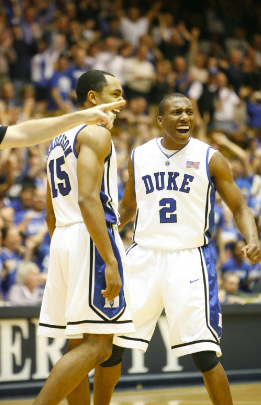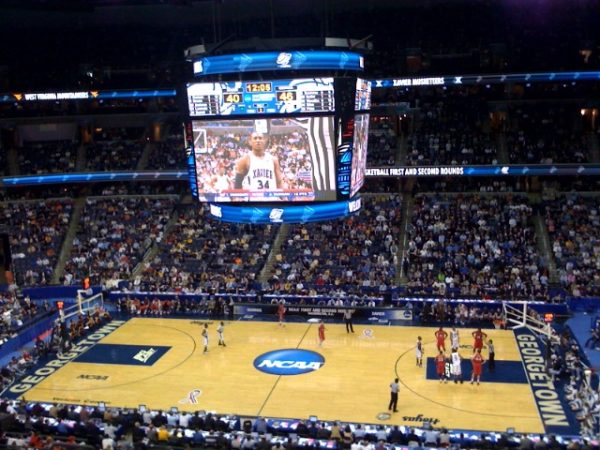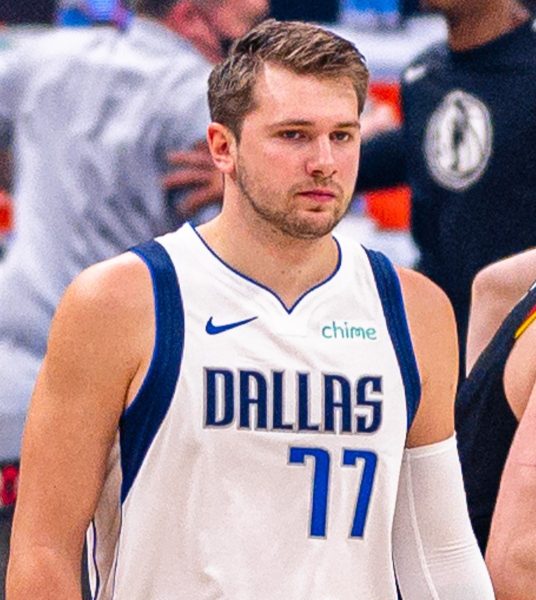How a Player’s March Madness Performance Predicts Their NBA Success

Duke’s Nolan Smith (#2) and Gerald Henderson (#15) get hyped during the 2009 March Madness tournament. Courtesy of Chronicle
Each spring, college basketball players and fans from across the nation look forward to the biggest tournament of the season – March Madness. March Madness, a NCAA Division I men’s basketball tournament, is a single-elimination tournament of the top 68 teams in the nation that compete in seven rounds for the championship. A player’s success in this yearly tournament earns them more recognition from other players and sports fans throughout the nation, but does it predict their future in the NBA?
Several past and current NBA players have proven that NCAA tournament success correlates to greater recognition from NBA scouts. Let’s look at the number one overall picks of the NBA draft from the years 2008-2010 and their March Madness performance.
Memphis’s Derrick Rose was selected number one overall by the Chicago Bulls in 2008. The point guard, notable for his athleticism on the offensive and defensive end, led the Tigers to victory in the March Madness “Final Four” against the Russell Westbrook-led UCLA Bruins. However, the Tigers were unable to cap off their near-perfect 38-1 season in their loss to the Kansas Jayhawks in the NCAA Championship. Despite this, Rose received immense recognition from NBA scouts, earning him the highest position in the 2008 NBA Draft.
Fast forward a season later, when the Los Angeles Clippers selected Oklahoma’s Blake Griffin with the first pick in the 2009 Draft. In his sophomore season, big man Griffin averaged 28.5 points, 15 rebounds, and 2.3 assists in March Madness. Griffin led the Sooners to the Elite Eight, where they were knocked out by the Siena Saints with a late-overtime three-pointer. Griffin’s sophomore-year performance earned him the Naismith Wooden and AP Player of the Year and the highest position in the 2009 NBA Draft.
In 2010, Kentucky’s John Wall was selected first overall by the Washington Wizards. In his freshman year, Wall averaged 14.5 points, 5 rebounds, 7.8 assists, and 1.5 steals per game. The quick, skilled-ball handling point guard led the Wildcats to the Elite Eight before falling to West Virginia. Despite his early exit from the tournament, his performance and ability to lead the Wildcats to a 35-win season earned him All-American and SEC Player of the Year.
The success of these players went far beyond their high selection in the NBA Draft. Derrick Rose earned the 2011 MVP and 2009 Rookie of the Year awards. Amid a breakout sophomore season, Rose suffered a torn ACL in his left knee during the 2012 Playoffs. Some believe that Rose would have been among the best point guards of all time if he hadn’t suffered such a long-term injury, and he has demonstrated that he no longer possesses the same skill he once held. “D’Rose was one of the best players at the time, I thought he was about to earn his second MVP award. He hasn’t been the same player since his injury – it affected his ability to reach his full potential,” expresses NBA fan Camila Chavarria.
Similar to Rose, Griffin earned the Rookie of the Year award in 2011. In addition to this, Griffin made the All-NBA team 5 times.
Wall also made the All-NBA Team, as well as the All-Defensive and All-Rookie teams.
Rose, Griffin, and Wall have combined for 13 All-Star appearances. All three players are still striving for their first NBA title.
These three former college stars are just a few of the many NBA players whose successful careers sprouted from their performance during the madness of March. For college basketball players, March Madness is more than just about having fun – it is about demonstrating their ability to compete in the “big league” NBA. Several past and current NBA players have demonstrated the importance of playing competently and standing out in college basketball tournaments.





